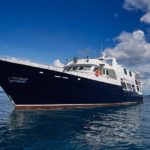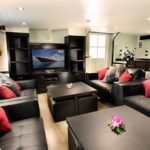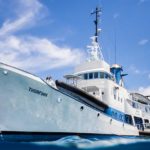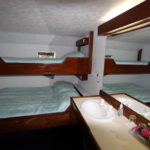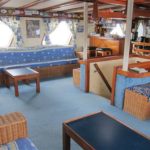Truk (or Chuuk) Lagoon is the final resting site for the debris from World War II battle Operation Hailstone. With a Truk Lagoon liveaboard, divers today can explore this “Japanese Ghost Fleet” scattered over more than 50 wreck sites.
The flash attack by the Allies on the Japanese military sent over 60 ships and 200 planes to the bottom of the lagoon. Half a century after the attack, the wrecks have been encrusted with coral and are home to schools of colorful reef fish. The deeper channels are full of sharks, who are attracted by the nutrient-rich waters.
Truk Lagoon is a sheltered lagoon in the middle of the Pacific Ocean. Although the lagoon is quite shallow, it’s worth getting certified for tec and rebreather diving so you can take full advantage of the deeper wrecks. For that reason, a Truk Lagoon liveaboard trip is best suited to advanced divers.
QUICK ANSWER – BEST TRUK LAGOON LIVEABOARD TRIPS
TRUK MASTER → For Extended Itineraries
SS THORFINN → For Luxury
BOAT REVIEWS
TRUK MASTER
Photo Credit: Truk Master Liveaboard
BEST FOR → EXTENDED ITINERARIES
If you’re a hardcore shipwreck enthusiast visiting Chuuk, this boat is your best bet. Extended itineraries lasting up to 11 days will give you the chance to dive all the region’s best wrecks, some more than once.
A spacious dive deck, individual gear stations, and valet equipment care make it easy to enjoy 4 dives a day. You can expect modern onboard facilities designed with tech and rebreather divers in mind, plus separate rinse bins and stations for cameras. With only 16 guests onboard, divers receive plenty of one-on-one service in and out of the water.
SS THORFINN
Photo Credit: SS Thorfinn Liveaboard
BEST FOR → LUXURY
After a long day underwater, some divers prefer a little bit of luxury on their liveaboard. The SS Thorfinn offers all the equipment and facilities wreck, tech, and rebreather divers need. Plus, a handful of creature comforts like a luxury stateroom, jacuzzi, and free internet.
This boat offers a variety of diving packages, too. Options including 3 to 5 tanks per day, courses, and specialized services for tech divers make it easy to customize your trip. So, no matter what level of certification or experience you hold, you can make the most of your time in Chuuk.
CONSIDERATIONS – SCUBA DIVING IN TRUK LAGOON
DIFFICULTY
Advanced. Diving in Chuuk Lagoon is all about shipwrecks. If you’re planning a trip to the region, you should have an advanced certification or above. Liveaboards here do offer specialty courses for wreck diving, introductory tech courses, and more. But, you’ll get more out of your trip if you already have experience diving beyond 40 meters and penetrating shipwrecks.
LENGTH
8 to 12 days. Classic Chuuk itineraries spend 8 days diving the lagoon’s shipwrecks. These trips stop at the region’s best-known sites, sometimes for more than one tank. But, if you want to visit less dived wrecks in the area, you’ll need at least 10 days. Longer voyages include a few reef dives too. Impressive coral gardens and plenty of big fish make the extra immersions worthwhile.
SEASON
Liveaboards visit Chuuk all year round. The peak season between December and April is best for spotting whale sharks and mantas on the lagoon’s outer reefs. Though, it will mean higher prices and more crowded dive sites, too. Between May and November, it rains every day, but diving conditions and visibility are rarely affected.
WEATHER
No matter when you visit Chuuk lagoon, you should plan for tropical weather. Pack for heat, humidity, and daily downpours. Water temperatures fluctuate between 71 to 86° F (22 to 30° C) throughout the year, and a full 3 to 5mm wetsuit is mandatory for wreck diving. Pack gloves and a hood for extra protection during penetration dives.
VISIBILITY
Chuck lagoon’s protection from the open ocean helps to maintain its good visibility throughout the year. Though the rainy season can bring murky surface conditions, this seldom affects deeper sites. Keep in mind that the shipwrecks lie on a sandy bottom, covered with a dense layer of silt. Perfect neutral buoyancy is essential for maintaining water clarity while diving.
WHAT TO EXPECT
The highlight for liveaboard divers in Chuuk lagoon is a chance to explore its legendary “ghost fleet” of shipwrecks. More than 60 boats sunk here during The Second World War’s Operation Hailstone. The majority of these were Maru cargo vessels outfitted for combat. But, a few naval ships went down in these waters, too. Diving in this region requires an advanced certification at a minimum. But, the more experience you arrive with, the more you will enjoy your trip. Many of the best sites here are only open to tech divers thanks to their extreme depths.
Liveaboard diving in Chuuk is different. If you’re going deep, your days will begin earlier and end later. You’ll need the extra time to off-gas. Don’t expect long rides to and from dive sites here, as your liveaboard will likely moor directly over the wrecks that you are diving. This is especially true if you are planning to reach technical depths. And, because you will be making decompression stops on every dive, boats offer “deco bars” with extra cylinders and lines to relax on while you wait. Less experienced clients will be taken to alternate sites, typically on a nearby reef, when scheduled dives are beyond their skill level.
One of the most captivating parts of diving in this region is a chance to see historical WWII artifacts. Tanks, deck guns, weapons and ammunition, gas masks, and other memorabilia litter the wrecks. Though most have been removed, there are still human remains in the deeper reaches of some boats. Divers should keep in mind that undeployed ammunition is unstable, and should never be touched. And, out of respect for the 3000 people who died here, items found within the wrecks should never be disturbed.
In addition to the lagoon’s shipwrecks, divers can expect an incredible variety of wildlife. Micronesia is home to stunning biodiversity, and Chuuk is no exception. Reef sharks, manta rays, and whale sharks inhabit this region. So, keep your eyes out in the blue, especially during safety stops. And, the wrecks themselves have transformed into extensive artificial reefs. These isolated marine ecosystems are home to a variety of macro life and provide shelter for schooling tropical fish. The coating of coral and sponges add a vibrant pop of color to this otherwise somber dive destination.
The best part of diving in Chuuk lagoon is the chance to explore its legendary “ghost fleet” of over 60 shipwrecks. Most of the boats sunk here during The Second World War’s Operation Hailstorm were Maru cargo vessels outfitted for combat. But, a few naval ships went down in these waters, too. Diving in this region requires an advanced certification at a minimum. But, the more experience you have, the more you’ll enjoy the trip. Many of the best sites here are only open to tech divers thanks to their extreme depths.
Liveaboard diving in Chuuk is different. Your days will begin earlier and end later, allowing for extra time to off-gas. Plus, you won’t have long rides to and from dive sites. Your liveaboard will likely moor directly over the wrecks that you are diving. And, because you’ll make decompression stops on every dive, boats offer “deco bars” with extra cylinders and lines to relax on while you wait.
One of the coolest parts of diving in this region is a chance to see historical WWII artifacts. Tanks, deck guns, weapons and ammunition, and gas masks litter the wrecks. And, there are still human remains in the far reaches of some of the deepest boats. Keep in mind that undeployed ammunition is unstable, and should never be touched. And, out of respect for the 3,000 people who died here, items found within the wrecks should remain undisturbed.
In addition to the lagoon’s shipwrecks, divers can expect an incredible variety of wildlife. Micronesia is home to stunning biodiversity, and Chuuk is no exception. Reef sharks, manta rays, and whale sharks inhabit this region. So, keep your eyes out in the blue, especially during safety stops. The wrecks themselves have transformed into extensive artificial reefs. This coating of coral and sponges add a vibrant pop of color to an otherwise somber dive destination.
HIGHLIGHTS – DIVING IN TRUK LAGOON
WRECKS
Wreck diving is the number one attraction in Chuuk lagoon. Nicknamed the “Ghost Fleet,” the ships that sunk here were all casualties of WWII. Still outfitted with guns and ammunition, they are a dark reminder of Micronesia’s wartime history. Today, the wrecks are a hotspot for underwater photographers thanks to their historical artifacts and colorful coral growth.
TECH DIVING
Many of Chuuk’s wrecks lie below the recreational depth limit for scuba divers. Some, as deep as 220 feet (70 meters). Visiting these will require training and certification in technical diving. Opportunities for techies in this region include gas blending, rebreathers, sidemount, and more. All liveaboards here offer tech packages. But, you should check pricing and availability with your operator well in advance.
MANTA RAYS
Though other parts of Micronesia like Yap are more famous for mantas, they frequent the waters around Chuuk lagoon, too. A resident population of rays lives here all year round. But, between December and April the population booms as migratory mantas come to breed. Keep watch out in the blue, especially during deco stops, and you might just spot one.
WHALE SHARKS
Like Chuuk’s manta rays, whale sharks live here all year round. But they aren’t seen as often. Your best chances are between January and April. During these months, the sharks gather near the lagoon to feed on blooming plankton. You have a better chance of spotting whale sharks on the surface, but lucky divers sometimes encounter them at depth.
ITINERARIES IN TRUK LAGOON
CLASSIC CHUUK LAGOON
Like the rest of Micronesia, getting to Chuuk Lagoon takes time. If you’re flying from Europe or North America, you should plan for at least a day or two of travel each way. So, weekend getaways are out of the question. How long you decide to stay will determine which of the region’s shipwrecks you visit and how many times.
Classic trips last for 7 or 8 days, topping out at around 20 tanks. These itineraries stop at all the lagoon’s best wrecks. In fact, most liveaboards visit more than a dozen different WWII era ships during each cruise. And, you can expect at least a couple of dives on local reefs, too. If you’ve never been diving in Chuuk, this type of voyage is probably your best bet. You’ll get plenty of time to explore the area without a huge time commitment or the risk of burnout.
EXTENDED
SIf you’re a real wreck junkie or already familiar with diving in Chuuk, longer trips are available, and often a better value. Why fly all that way and not maximize your time underwater? 11 and 12 day itineraries spend more time at the best wrecks and visit a few of the more remote ones, as well. This gives technical divers more time to plan penetration routes and challenging deep dives. Plus, photographers can take an extra crack at the perfect shot on the region’s most iconic shipwrecks. If you’re hoping to spot some of the lagoon’s famous wildlife, a more extended cruise will score you more reef dives, too.
No matter what itinerary you choose, you’ll only get a couple of dives in on the first and last days of your trip. And, because you’ll be diving deeper profiles, you’ll need to wait at least 24 hours before flying home. Be sure to keep these factors in mind when deciding which type of voyage works best for you.
VIDEO: SCUBA DIVING IN TRUK LAGOON
BEST DIVE SITES AROUND TRUK LAGOON: TONOAS WRECKS
HEIAN MARU
The Heian Maru is the largest ship remaining in Chuuk Lagoon, and the easiest to dive. This wreck’s side hull begins at just 40 feet (12 meters). And on clear days, even snorkelers can catch a glimpse from the surface. Her wide passageways leading to a spacious bridge and engine room make for the region’s easiest penetration routes, too. Most liveaboards explore this wreck early in their itineraries or as a “checkout dive” to test equipment and buoyancy. The Heian is also a popular site for training and specialty certification.
SAN FRANCISCO MARU
Lying upright in deep water, the San Francisco Maru is only dived by those with technical qualifications. Her hull begins at 140 feet (42 meters) and drops all the way to 210 feet (64 meters). This wreck is one of the lagoon’s most fascinating and intact. And, thanks to her depth, she is still loaded with wartime artifacts. A stunning bow gun, light tanks, and flatbed trucks are favorite wide-angle subjects for underwater photographers. In the hold, small items like ammunition crates, artillery shells, torpedos, depth charges, and mines remain partially visible through layers of silt.
FUJIKAWA MARU
Known as the “showcase wreck”, this is Chuuk’s most dived site. Her huge bow and stern deck guns are the region’s best for photography thanks to their impressive size and coral growth. Inside her forward holds, artifacts like fuel drums, shells, guns, and aircraft parts are easily accessed making this a great site for less experienced wreck divers. Best of all, the ship’s exterior is home to vibrant marine life. Pelagic species like sharks and rays are spotted during day dives. At night, the Fujikawa’s coral gardens transform into a paradise for macro life.
HOKI MARU
Popular among tech divers, the Hoki Maru holds some of the region’s most fascinating cargo. This ship sank with her hold full of military vehicles and weaponry. Bombs, ammunition, and depth charges litter the interior. Trucks, tractors, bulldozers, and a steamroller rest upright, covered with years of sediment. These unique artifacts make this a favorite for underwater photographers, and some of the region’s most iconic images come from this wreck. Because of her depth, the Hoki Maru remains off-limits to recreational divers.
BEST DIVE SITES AROUND TRUK LAGOON: WESTERN WRECKS
SHINKOKU MARU
Resting upright in 130 feet (40 meters) or water, the Shinkoku Maru is a “must see” wreck. The ship’s superstructure is encrusted with colorful coral, creating one of the region’s most stunning artificial reefs. Lucky groups might spot sharks, rays, and other large pelagics here by day. At night, the hull crawls with macro life like nudibranchs, crabs, and shrimps. External exploration dives at less than 100 feet (30 meters) make this wreck a top pick for less experienced divers and students. But, there are plenty of options for penetration, too.
FUMITSUKI DESTROYER
One of the only true warships found in Chuuk, the Fumitsuki is a Japanese destroyer. The wreck’s main external attractions are intact bow and stern guns, depth charge guns, and torpedo launchers. Popular with technical divers, this ship is best known for exciting penetration routes. Because she was made for war, her internal spaces are much smaller than Maru class cargo ships found in the region. This makes for a more challenging environment. But, diving the Fumitsuki is well worth the extra effort. Historical artifacts like ammunition, uniforms, and gas masks are among this wreck’s thrilling finds.
BEST DIVE SITES AROUND TRUK LAGOON: FEFAN WRECKS
KENSHO MARU
One of Chuuk’s most popular wrecks for penetration, the Kensho Maru has plenty to offer divers of various skill levels. Her deck starts at 80 feet (24 meters) with an elevated wheelhouse encrusted in colorful coral. The real draw to this ship is her accessible engine room. An easy penetration route leads to this large chamber, making it perfect for wreck specialty students and underwater photography. This wreck is a great place to spot wildlife, too. Whether you’re hoping to spot large pelagics passing overhead or delicate macro, your chances are good, here.
I-69 SUBMARINE
Many of the wrecks in Chuuk are known for tragic wartime history, but the I-69 submarine has one of the region’s saddest stories. The entire crew of 9 officers and 75 men suffocated to death in her hull, which is now off limits to divers. External exploration is still possible, and popular thanks to the rarity of submarine wrecks in the South Pacific. Poor water quality and a silty seabed have prevented coral growth and preserved her outward appearance. The sub’s hatches and exposed pressure hull are the most notable attractions for photographers.
BEST DIVE SITES AROUND TRUK LAGOON: UMAN WRECKS
RIO DE JANEIRO MARU
Every liveaboard in Chuuk Lagoon visits the Rio de Janeiro Maru. Divers of all experience levels can explore this large passenger liner, found close to shore in shallow water. Her main exterior attractions are a massive stern gun and propellers, and vibrant marine life. Large explosion holes in the bow lead to a maze of wide passageways, perfect for exploring the ship’s interior. If you’re planning on penetrating this wreck, don’t miss the engine room and holds. Interesting wartime artifacts like beer bottles and gun barrels litter her inner chambers.
GOSEI MARU
The Gosei Maru is one of Chuuk’s best wrecks for spotting marine life, thanks to a colorful garden of coral covering her hull. Lucky groups might even spot large pelagics like manta rays passing overhead. And, sharks are sometimes spotted patrolling the ship’s exterior. The Gosei Maru lies on her port side, on a steep incline. Her propeller, found in shallow water, is a favorite for photographers thanks to its depth and excellent natural lighting. Other highlights on this wreck include torpedo bodies found in the holds, shells, lanterns and fuel drums.
OTHER LIVEABOARD DESTINATIONS
For more of our liveaboard recommendations, check out these popular articles:
Caribbean | Bahamas | Belize | Cuba | Turks & Caicos
North Pacific | Galapagos | Guadalupe | Socorro | Cocos
South Pacific | Australia | Palau | Fiji | French Polynesia | PNG | Solomon Islands
South East Asia | Raja Ampat | Komodo | Similan | Tubbataha | Burma
Red Sea & Middle East | Egypt | Sudan | Oman | Djibouti
Indian Ocean | Maldives | Seychelles | Visayas
READ MORE
For more of our top scuba diving gear recommendations, check out these popular buyer's guides:






